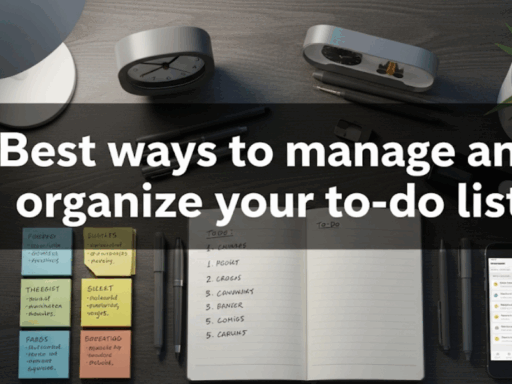Time Blocking for Maximum Flow in Professional Lives: The Ultimate Guide to Time Management For Busy Professionals
In today’s fast-moving business environment, good planning is what distinguishes high achievers from those who merely survive. If you are always the one putting out fires and catching up on deadlines or simply unable to keep track of all your work, you are not alone. What are the secret weapons top performers use? Strategic weekly planning.
It’s not just making to-do lists for the week. It is about creating a blueprint for stopping to chase continuously after all these objectives you feel have not been achieved, that reminds you what the most important things are, reduces stress and helps you consistently meet your objectives. This guide will walk you through time-tested methods to increase your productivity, just like many busy professionals.
The Power of Weekly Planning Compared to Daily Planning
A lot of the people you see are trying to get by planning their days one at a time, this tends to make them reactive instead of proactive. Weekly planning helps you get the bigger picture so that way, you can plan better what to do with your time.
Weekly Planning allows you to:
- Proactively resolve resource conflicts before they arise
- Write down what you have to do on one side of the page, and on the other write down what you want to accomplish in 3 months that is not urgent but important
- Focus on deep work and creative tasks
- Be realistic about what you can achieve
- Incorporate a margin for surprise opportunities or challenges
According to research from Harvard Business School, individuals who set goals weekly are 40% more likely to be successful in reaching their goals than those who only set daily goals.
The Science Behind Weekly Planning
Structured planning is easier for a brain to understand. In the science world, this is referred to as ‘cognitive load theory’ but put simply: reducing the mental energy required to work out what you have to do next frees up brain power for actually doing it.
This is also where weekly planning taps into something psychologists know as the “Zeigarnik effect.” What it means is that your brain will keep pestering you about things if they are not done or written down with a clear goal. By keeping everything recorded in your weekly plan, your mind is free for execution and not for remembering.
The 5-Step Weekly Planning Framework
The system I am about to show you is one that costs 30–45 minutes every week but saves you hours of wasted time, frustration and stress.
Step 1: Weekly Review + Brain Dump
To begin, let’s just look back on the week that was. Ask yourself:
- What went well this week?
- What didn’t go as planned?
- What should I take note of for the next week?
Then open your journal and make a complete “brain dump” onto paper of everything that is in your head for the week ahead. Do not organize it yet — just dump all things which are there in your head to paper/digital tool.
Step 2: Sort and Rank Your To-Dos
Brain dump your ideas into the following categories:
Must Do This Week:
- Tasks with hard deadlines
- Commitments to other people
- Critical business priorities
Should Do This Week:
- Important but not urgent tasks
- Projects focused on your long-term goals
- Preparation work for future deadlines
Could Do This Week:
- Nice-to-have tasks
- Learning opportunities
- Administrative tasks that can wait
Step 3: Block Your Calendar
This is the magic part — actually scheduling your priorities in your calendar. Here’s how:
- Fixed commitments: Meetings, appointments, etc. — stuff you cannot wiggle out of
- “Must Do” tasks: Schedule them for when you are typically the most alert
- Buffer time: Build 15–30-minute cushions between time-blocked tasks
- Email and communication: Block specific times — do not let it interrupt deep work
- Breaks and personal time: Your brain works much better when you are rested
Step 4: Energy Management Planning
Not every hour is created equal. Organize your tasks to take advantage of your energy levels:
High Energy Times (usually mornings):
- Creative work
- Problem-solving
- Important decision-making
- Challenging projects
Medium Energy Times:
- Routine tasks
- Email and communication
- Planning and organizing
- Team meetings
Low Energy Times:
- Administrative work
- Data entry
- Reading and research
- Reflection and review
Step 5: Build in Flexibility and Contingencies
Life has a way of just happening sometimes and plans change no matter how well organized you think they are. Smart weekly planners:
- Block out 20 percent of their time for unexpected priorities
- Maintain a “backup to-do list” for when meetings are cancelled
- Have mini-goals for important tasks in case time is limited
- Create if-then scenarios (If this meeting finishes early, then I’ll work on project X)
Advanced Weekly Planning Techniques
The Theme Day Method
Some professionals assign a particular theme for each day of the week:
- Monday: Planning and strategy
- Tuesday: Client work & meetings
- Wednesday: Deep work & project time
- Thursday: Team collaboration & internal meetings
- Friday: Review, reflect & set up for next week
This helps minimize decision fatigue and allows you to batch similar types of work together.
The 3-2-1 Weekly Structure
Another successful strategy is to think of your week in the following way:
- 3 most important tasks that must be completed
- 2 key projects to move forward
- 1 investment in future learning or development
This helps you concentrate on important work while ensuring your professional development is not ignored.
Energy-Based Weekly Planning
Track your energy patterns for a few weeks and build your weekly schedule around them:
| Time | Monday | Tuesday | Wednesday | Thursday | Friday |
|---|---|---|---|---|---|
| 9-11 AM | Creative Work | Deep Focus | Problem Solving | Strategic Planning | Project Review |
| 11-1 PM | Meetings | Client Calls | Team Collaboration | Presentations | Wrap-up Tasks |
| 2-4 PM | Email/Admin | Research | Writing | Analysis | Planning Next Week |
| 4-6 PM | Follow-up | Preparation | Routine Tasks | Communication | Personal Development |
5 Digital Tools for Weekly Planning
Calendar-Based Planning Tools
Google Calendar or Outlook:
- Use color coding for different work types
- Create time blocks for routine activities
- Set up smart notifications
Clockify or RescueTime:
- Track what you spend time on vs. what you had planned
- Identify patterns and areas for improvement
- Use reports to optimize your planning
Task Management Systems
Todoist or Asana:
- Create projects for each area of your work
- Use labels and filters to categorize tasks by importance
- Set up recurring tasks for routine weekly activities
Notion or Monday.com:
- Build comprehensive weekly planning templates
- Link tasks to broader projects and goals
- Get detailed analytics and progress tracking
Hybrid Planning Approaches
Successful professionals often combine digital and analog tools:
- Digital calendars for appointments and scheduling
- Physical notebooks for daily task lists and notes
- Apps for team collaboration and sharing
- Paper-based systems for reflection and strategic planning
Role-Specific Weekly Planning Templates
For Managers and Team Leaders
Your weekly plan should include:
Monday – Strategic Focus:
- Review team performance from last week
- Plan key initiatives and priority projects
- Schedule one-on-one meetings with team members
Tuesday-Thursday – Execution and Collaboration:
- Mix of individual deep work and team collaboration time
- Client or stakeholder communications
- Progress reviews on ongoing projects
Friday – Review and Preparation:
- Evaluate weekly results and lessons learned
- Prepare for upcoming week’s priorities
- Block time for professional development or strategic thinking
For Sales Professionals
Prospecting and Lead Generation:
- Block time in the early part of the week for cold outreach
- Schedule follow-up calls with warm prospects
- Research potential new clients and markets
Client Management:
- Regular check-ins with existing clients
- Product demos and presentations
- Proposal writing and contract work
Administrative and Planning:
- CRM updates and activity logging
- Pipeline analysis and forecasting
- Plan follow-up activities for next week
For Consultants and Freelancers
Client Work:
- Deep work blocks for project deliverables
- Client calls and check-in meetings
- Research and preparation time
Business Development:
- Networking events and relationship building
- Proposal writing and project bidding
- Marketing and content creation activities
Administrative Tasks:
- Invoicing and financial management
- Professional development and skill building
- Business planning and strategy
Weekly Planning Pitfalls to Avoid
The Overcommitment Trap
Many professionals overstuff their weekly schedule, failing to account for:
- Unexpected urgent tasks
- Tasks taking longer than expected
- Thinking and processing time
- Breaks and mental recovery
Solution: Plan for only 70-80% of your available time. The remaining 20-30% serves as buffer for the unexpected.
Ignoring Energy Patterns
Scheduling your most important work during low-energy times is like trying to run uphill. Notice when you naturally feel most alert, creative and focused — and guard those times fiercely for your most important work.
Not Connecting Weekly Plans to Bigger Goals
Weekly planning isn’t just about managing tasks — it’s about making consistent progress toward your larger objectives. Every week should move you closer to your quarterly and annual targets.
Solution: Start each weekly planning session by reviewing your bigger goals and asking: “What can I do this week to make meaningful progress?”
Not Building in Recovery Time
Your brain needs time to process information, generate ideas, and rest. Scheduling back-to-back activities throughout the week leads to burnout and decreased productivity.
Solution: Build regular transition time between tasks and schedule at least one substantial break each day for thinking and recovery.
Advanced Time Management Techniques for Weekly Planning
Using the Pomodoro Technique in Weekly Planning
Incorporate the Pomodoro Technique into your weekly plan:
- 25-minute focused work sprints
- 5-minute breaks between pomodoros
- Longer breaks (15-30 minutes) every few hours
- Use timers to ensure you stick to your time blocks
Batch Processing for Maximum Efficiency
Group similar tasks together to minimize mental switching costs:
Communication Batches:
- Check and respond to emails only at set times (9 AM, 1 PM, 5 PM)
- Block time for phone calls
- Schedule all meetings for certain days if possible
Deep Work Batches:
- Block 2-4 hours for project work
- Turn off notifications during these times
- Focus on one major task at a time
Administrative Batches:
- Process expenses and paperwork together
- Do all planning and organizing together
- Handle routine tasks in dedicated blocks
Weekly Planning with the 80/20 Rule
The Pareto Principle states that 80% of your results come from 20% of your efforts. Apply this to your weekly planning:
- Identify your high-impact activities — the 20% of tasks that generate 80% of your results
- Priority schedule: Block these activities first in your schedule
- Minimize low-impact tasks: Delegate, automate, or eliminate certain activities
- Track results: Monitor which activities actually move the needle
How to Measure Your Weekly Planning Success
KPIs for Planning Effectiveness
Track these metrics to improve your weekly planning:
Completion Rate:
- What percentage of planned tasks did you complete?
- Target: 80-90% completion rate
Goal Alignment:
- How much time did you spend on activities aligned with your major goals?
- Target: At least 50% of your time on goal-aligned work
Stress and Satisfaction Levels:
- Rate your stress levels and job satisfaction 1-10 each week
- Look for patterns and correlations with your planning approach
Energy Management:
- Track your energy levels and productivity throughout the week
- Optimize your schedule based on your natural energy patterns
Weekly Review Questions
Each week, ask yourself:
- What were my three biggest wins this week?
- What took longer than expected and why?
- What interruptions could I have prevented with better planning?
- How accurate was my time estimation?
- If I could plan this week again, what would I do differently?
- What patterns do I notice in my productivity and energy?
Building Your Personal Weekly Planning System
Choose Your Planning Day and Time
Most successful people do their weekly planning:
- Friday afternoon: Plan next week while this week is still fresh in your mind
- Sunday evening: Start the week with focus and intention
- Monday morning: Begin the week with fresh energy and perspective
Choose a time when you can think clearly without distractions. Block it in your calendar — this time is as important as any meeting.
Create Your Planning Ritual
Make your weekly planning session something you look forward to:
- Find a quiet, comfortable planning space
- Have your favorite drink or snack
- Use tools and materials you enjoy
- Play focus music if it helps
- Make sure your planning session feels complete
Build Flexibility Into Your System
Your planning system should evolve as your role and responsibilities change. Check in monthly on your planning process:
- Is this still working for me?
- What’s working well in my process?
- What am I spending too much or too little time on?
- How can I make this process faster or more enjoyable?
Weekly Planning for Work-Life Balance
Integrating Personal and Professional Planning
The best weekly planning systems integrate both work and personal commitments:
Professional Blocks:
- Client work and meetings
- Project deadlines and deliverables
- Team collaboration and communication
- Professional development activities
Personal Blocks:
- Family time and relationships
- Health and fitness activities
- Hobbies and personal interests
- Rest and recovery time
Setting Boundaries and Saying No
Good weekly planning helps you see your actual capacity and stick to it:
- Say no to requests that don’t align with your goals
- Push back on unrealistic deadlines when you’re at capacity
- Delegate tasks that others could do
- Protect time for important but not urgent work
Energy Protection Strategies
Design your week to preserve and restore your energy:
Energy Drains to Limit:
- Back-to-back meetings without breaks
- Switching between very different types of work
- Dealing with difficult people or situations when you’re already drained
- Doing high-energy tasks during your low-energy times
Energy Boosters to Include:
- Short walks or physical movement between tasks
- Working with colleagues or clients you enjoy
- Projects you’re passionate about
- Learning new skills or taking on interesting challenges
Adapting Weekly Planning to Your Work Style
For the Detail-Oriented Planner
If you love comprehensive organization and detailed planning:
- Use project management software with robust planning features
- Break down tasks into subtasks with time estimates
- Track actual vs. planned time for better future estimates
- Set up automated reminders and follow-up systems
For the Flexible, Adaptive Planner
If you work in a rapidly changing environment and prefer to keep options open:
- Plan in broader time blocks rather than minute-by-minute schedules
- Keep a “maybe” list for optional tasks
- Build extra buffer time around every commitment
- Focus on daily priorities within a loose weekly framework
For the Visual Planner
If you’re a visual thinker:
- Use calendar views rather than task lists
- Create visual project timelines and milestones
- Use color coding for different types of work
- Make mind maps and flowcharts for complex projects
Leveraging Technology for Modern Weekly Planning
Automation Tools That Save Time
Calendar Management:
- Use scheduling tools like Calendly for automated booking
- Set up recurring meetings and appointments
- Create calendar templates for common weekly structures
Task Management:
- Automate task creation from emails using tools like Zapier
- Set up templates for recurring weekly tasks
- Integrate task management systems with your calendar
Communication Management:
- Create email filters and rules for incoming messages
- Set up auto-responses during deep work blocks
- Schedule emails to send at optimal times
Cross-Platform Synchronization
Your weekly plan should be accessible wherever you work:
- Choose tools that sync across all your devices
- Ensure offline access to your plans
- Back up important planning information
- Use cloud storage for key planning documents
Troubleshooting Common Weekly Planning Challenges
When Plans Fall Apart
Even the best weekly plans sometimes go sideways. Here’s how to handle it:
For Minor Disruptions:
- Shuffle the rest of your week to accommodate new priorities
- Move less urgent tasks to later in the week
- Use your buffer time for unexpected priorities
For Major Disruptions:
- Schedule a mid-week re-planning session to reset priorities
- Focus on your most important commitments and let go of the rest
- Use the disruption as learning for better future planning
Dealing with Perfectionism
Some people get bogged down trying to create the perfect weekly plan. Remember:
- A good plan you follow is better than a perfect plan you abandon
- Your planning system should evolve and improve over time
- Start simple and add complexity gradually
- Progress, not perfection, is the goal
Managing Multiple Roles and Responsibilities
If you wear many hats in your professional life:
- Color code or categorize different roles
- Block significant time for each major role
- Avoid mixing different types of work within the same time block
- Regular check-ins to ensure balance across all your roles
Weekly Planning: The Foundation for Long-Term Success
Connecting Weekly Plans to Monthly/Quarterly Goals
Add extra power to your weekly planning by connecting it to bigger picture objectives:
Monthly Goal Integration:
- Each week should support 1-2 key monthly goals
- Track monthly goal progress during your weekly review
- Adjust weekly priorities based on monthly goal progress
Quarterly Planning Connection:
- Link weekly activities to quarterly priorities
- Use quarterly objectives to guide weekly decision-making
- Review quarterly progress during monthly planning sessions
Building Planning Skills Over Time
Weekly planning gets better with practice. Focus on:
Month 1-3: Building the Habit
- Keep your system simple and consistent
- Plan every week without exception
- Don’t worry about perfecting the process yet
Month 4-6: Refining Your Approach
- Notice what’s working and what isn’t
- Experiment with different tools and techniques
- Start optimizing for your unique work style
Month 7-12: Mastering Advanced Techniques
- Implement sophisticated energy management and prioritization
- Build systems for managing complex, long-term projects
- Start mentoring others on effective planning practices
Your Weekly Planning Action Plan
Ready to unlock the productivity power of weekly planning? Here’s your step-by-step action plan:
Week 1: Setup and Foundation
- Choose your planning day and time
- Select your primary planning tool (digital or analog)
- Block 45 minutes in your calendar for weekly planning
- Complete your first weekly planning session using the 5-step framework
Week 2-4: Building the Habit
- Maintain consistency in your weekly planning routine
- Track your completion rates and notice patterns
- Adjust your time estimates based on actual results
- Start incorporating energy management into your planning
Week 5-8: Optimization and Refinement
- Experiment with advanced techniques like theme days or the 3-2-1 structure
- Fine-tune your tools and explore automation
- Begin connecting your weekly plans to monthly and quarterly goals
- Develop your personal weekly planning ritual and environment
The Long-Term Impact of Consistent Weekly Planning
Professionals who stick to a regular weekly planning routine report dramatic improvements within just a few months:
- Increased productivity: Task completion rates typically improve by 25-40%
- Reduced stress: Fewer surprises and last-minute rushes
- Better work-life balance: Clearer boundaries and protected personal time
- Accelerated career growth: Consistent progress toward professional goals
- Higher job satisfaction: Greater sense of control and accomplishment
Your Next Steps to Planning Success
Weekly planning isn’t just another productivity hack — it’s a fundamental skill that can transform how you work and live. The key is to start simple, stay consistent, and evolve gradually as you see what works.
Remember, the best planning system is the one you’ll actually use. Don’t try to implement every technique at once. Start with the basic 5-step framework, build the weekly planning habit, then expand into more advanced strategies as they feel natural.
Your future self will thank you for taking control of your time and building this foundation. All it takes is 30-45 minutes per week to dramatically reduce stress and increase productivity and success in your professional life.
Take action now: Block 30 minutes in your calendar this week for your first strategic weekly planning session. That first planned week is the beginning of your journey to better time management and professional success.




